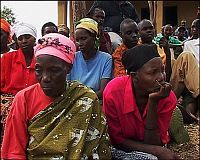Thursday, April 25, 2024
News and Views from the Global South
FILM-RWANDA: Genocidaires Face Off With Their Victims
Matthew Berger
- In 1994, hundreds of thousands of Tutsi were slaughtered by their Hutu neighbours, friends, and family members across Rwanda. Nine years later the killers came home from prison to live side by side again with their victims.

The women of Gafumba grapple with the return of their tormenters in "My Neighbour, My Killer". Credit: Gacaca Films
In this film, which will make its New York premiere at the Human Rights Watch International Film Festival on Jun. 20, speakers walk off screen while the camera remains fixed on the peaceful, pastoral backdrop behind them. It seems that so much has already healed in the decade that has passed, but the nightmares are still playing within the memories of the widows and children.
Elsewhere, jails are packed. Reintegrating those detainees into their former communities would not only relieve the drain on resources created by feeding inmates and the lack of workers in the fields but would allow victims an opportunity to confront their tormentors and maybe begin the healing process for the still-reeling communities.
To achieve this, the Rwandan government announced a plan in 2001 to set up approximately 11,000 community courts based on the traditional dispute resolution mechanism of Gacaca, or "justice on the grass".
In the process, as a Rwandan prosecutor explains to a group of detainees in the film, "Your lawyer will be your neighbour, your prosecutor will be your neighbour, your judge will be your neighbour."
Aghion followed the Gacaca process from its announcement, through the release of the prisoners in 2003, and up until the culmination of years of weekly testimony in 2008.
Over the decade, she made three other films as part of "The Gacaca Series", but "My Neighbour, My Killer" was the film she says she originally set out to make.
"There were various detours along the way that seemed worthy of short films," she explained in an interview with IPS.
Her experience, and thus the experience of the audience, is exclusively of the process in Gafumba. She got to know the people of the village and they began to trust her more and more.
Having the camera at their community trials clearly affected the experience of the community, but Aghion says it helped them to reflect on and confront their pasts. "My sense is that camera allowed them to address issues more freely," she said. "They were able to say things that they wouldn’t have said to each other otherwise."
One of the clearest examples of this is a scene in which, at the suggestion of an earlier interviewee, Aghion has invited some widows and other community members to sit and talk with Rwamfizi, a man who had terrorised their community in the genocide. They sip beer and milk and very slowly begin to speak about the horrible events from which they still cannot escape.
In another scene, the cameras rolls as one woman speaks to her friend about the impending return of the killers. They say they do not care if they return to finish the job and kill them off, that they wish they had been killed when their children were, that they are already dead.
Aghion also told IPS about how it seemed to her that Rwamfizi, who appears prominently in the film, was compelled to dwell more deeply upon his actions during the genocide because of the attention from the camera and crew.
Throughout the film, the villagers speak either directly to the camera or to each other; there is no narrator and no context is ever established. Aghion believes this allows the film to better portray the emotions of the people. "Letting things simply unfold in the film makes it make powerful," she said.
And it succeeds in this. She has pieced together a powerful and cohesive look at phenomena – community justice, post-conflict reconciliation, emotional healing – whose importance transcends the events in this central African country on which the world turned its back in 1994.
Her film forms a piece of a growing body of work on the Rwandan genocide which, in its way, is also part of a sort of healing process for the Westerners that were unable or unwilling to intervene.
The Gacaca themselves are a combination of healing and justice, according to Aghion, but an imperfect form of both. They produce neither perfect justice, nor satisfactory healing, she said.
With so many different courts in so many different communities, justice is understandably uneven, and some have objected that the process reawakens as many nightmares as it expels.
In Gafumba, the process is really winding down, she said, "but it’s still going on elsewhere."
Whether the process is working, though, she does not quite know, and this is a question the film leaves open.

 Print
Print



